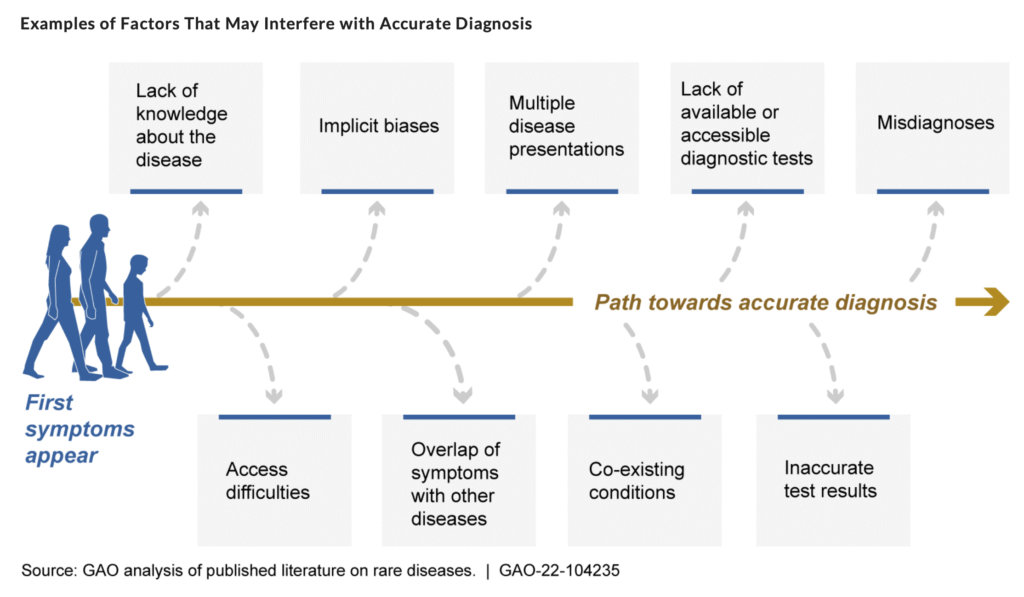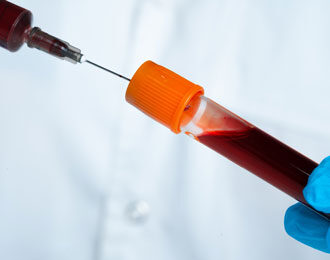Rare Diseases: Although Limited, Available Evidence Suggests Medical and Other Costs Can Be Substantial

GAO updated December 2021
In the U.S., about 30 million people—half of them children—have a rare disease. Many of these diseases are chronic, worsen over time, and are life-threatening. It can take years of testing and misdiagnoses to get a correct diagnosis; in that time, a patient’s health can get worse.
Partly due to the difficulty of diagnosing rare diseases, the costs related to them are hard to track. But available research suggests those costs may be substantial.
One study estimated total 2019 U.S. costs for rare diseases at $966 billion—including direct medical costs (e.g., drugs, doctor visits) and other nonmedical and indirect costs (e.g., loss of income).
What GAO Found
According to the literature GAO reviewed, diagnosis of any disease can be complicated, and diagnosis of rare diseases can be particularly difficult because of a variety of factors. (See figure.)
Although some rare diseases may be detected quickly, in other cases years may pass between the first appearance of symptoms and a correct diagnosis of a rare disease, and misdiagnoses—and treatments based on them—occur with documented frequency.
According to the literature GAO reviewed and GAO’s interviews, those with undiagnosed, misdiagnosed, or untreated rare diseases may face various negative outcomes.
For example, a person’s health can suffer when appropriate, timely interventions are not provided or when interventions based on misdiagnoses cause harm. In addition, multiple diagnostic tests, medical appointments, and ultimately unwarranted interventions can add to the costs of the disease.

Research on the costs of rare diseases is limited, in part because of the difficulty of diagnosing them. Nonetheless, the costs can be substantial, as indicated by available research from the U.S. and elsewhere and the experts, researchers, and organization officials GAO interviewed.
These costs—to those with rare diseases, health care payers, the U.S. government, or a combination—can include direct medical costs (e.g., costs of outpatient visits or drugs), direct nonmedical costs (e.g., costs to modify one’s home to accommodate a wheelchair), or indirect costs (e.g., loss of income or diminished quality of life).
Peer-reviewed studies of specific rare diseases estimated costs for people with rare diseases that are multiple times higher than costs for people without those diseases. One recent study, which has not yet been peer-reviewed, estimated $966 billion as the total cost (including medical and other nonmedical and indirect costs) in the United States for an estimated 15.5 million people with 379 rare diseases in 2019.
The Department of Health and Human Services (HHS) provided technical comments on a draft of this report, which GAO incorporated as appropriate.
Why GAO Did This Study
Few people have any specific rare disease. But there are many different rare diseases—about 7,000—and as a result, an estimated 30 million people in the United States have one or more of them. About half of those with a rare disease are children. Often genetic, many rare diseases are chronic, progressive (they worsen over time), and life-threatening. Relatively little is known about the costs of rare diseases, either individually or collectively.
The Joint Explanatory Statement for the Further Consolidated Appropriations Act, 2020, includes a provision for GAO to study the costs of rare diseases within the U.S. GAO examined, among other things, the challenges to diagnosing rare diseases and what is known about their costs.
Examples of Rare Monogenic Diseases— Diseases Due to a Single Genetic Aberration
Cystic fibrosis. Cystic fibrosis is a disease caused by mutations in the gene encoding a specific protein called the cystic fibrosis transmembrane conductance regulator protein; more than 900 mutations of this gene have been found. This disease causes mucus to build up and damage organs in the body, particularly the lungs, pancreas, and digestive tract. Over time, mucus buildup and infections can lead to permanent lung damage, as well as other symptoms and health risks. Most people with cystic fibrosis are diagnosed by age 2, in part because newborn screening can often detect it, but the disease might not be detected until adulthood.
Duchenne muscular dystrophy. Duchenne muscular dystrophy is a disease in which a specific gene–the DMD gene—does not function properly, resulting in a deficiency of dystrophin—a protein involved in maintaining the integrity of muscle. The disease results in progressive muscle wasting, and muscle weakness is usually noticeable in early childhood. Most children with Duchenne muscular dystrophy use a wheelchair in their early teens. Heart and breathing problems also begin in the teen years and lead to serious, life-threatening complications.
Rare diseases include a wide range of diseases that vary in cause, age of onset, affected organs, and other features. For example, potential causes include infection, bites or other exposures to poison, complications from transplants, and malformations during embryonic or fetal development. In some cases, the causes are not known. However, most rare diseases— often estimated at 80 percent—are genetic. And in contrast to most common diseases, rare diseases are often due to a single genetic mutation.
Research indicates that rare genetic diseases have a disproportionate effect on children, often by compromising the nervous system and so producing chronic, progressive, and degenerative effects. For example, these diseases may involve a deficiency in a substance the body needs or an excess of a substance that disrupts the body’s functioning.
In either case, the result is generally a chronic, progressive, and potentially life-threatening disease. The age of symptom onset depends on the time it takes for the effects of the deficiency to become clear or for the accumulation of a toxic substance to interfere with functioning. Depending on the substance, the results might involve multiple organ systems.
Although rare diseases often affect children, they can affect people of any age. They can also affect people of any racial or ethnic group, but some rare diseases (like some common diseases) occur more frequently in certain groups than others.





